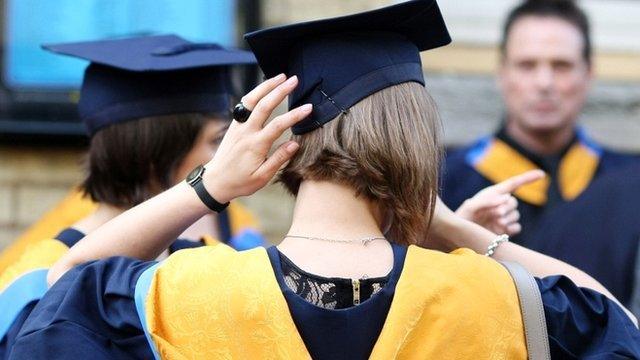With three D grades at A-level, 80% got university places
- Published

Among university applicants who got three D grades at A-level, 80% were successful in getting places in 2018, according to admissions figures.
This was a year with fewer 18-year-olds, which saw universities competing to attract students.
The Ucas admissions data shows Northern Ireland had the highest entry rate among the UK's four education systems.
But London was by far the highest region for university entry - a third more than elsewhere in England.
The Ucas annual report on university admissions shows this was a particularly good year for applicants.
A demographic dip in 18-year-olds and financial pressure to recruit saw many universities taking a generous approach to applicants, including those who did not reach their predicted grades.
Leeway on grades
Almost 77% of successful applicants had lower grades than had been predicted - and the admissions service says it wants to work with schools on getting more accurate predictions next year.
Those applicants getting three D grades were increasingly likely to get places - with 80% being successful.
Those getting CCC or lower had an 84% success rate.

About 10% were taking vocational qualifications such as BTecs instead of A-levels - and more than 80% of them were successful.
But those with high A-level grades - such as two or three grade As - had a slightly decreased chance of success this year, because of a rise in the number of applications to the most competitive places, such as medicine or for Oxford and Cambridge.
These high achieving students were still very likely to get a place, if not their first choice, with entry rates over 90%.
Overall, across all applicants with A-levels, there was almost a 90% chance that an applicant found a place.
This year showed a record proportion of 18-year-olds in England getting a university place - almost 34% and the sixth consecutive increase.
Northern Ireland continues to have the highest entry rate, at 35%, and Wales was 30%.
Scotland was lower, at 27%, but Ucas says this figure is reduced because the admissions service covers only part of the Scottish system.
London an outlier
There were big regional differences within England - with London significantly higher than anywhere else, with 42% of 18-year-olds in the capital going straight to university.
In comparison, in the South West the entry rate was 29% and 20% in the North East.
Education Secretary Damian Hinds said the figures showed the need for universities to work harder to recruit under-represented groups, regardless of where they lived or their social background.
"Whilst potential and talent is evenly spread, the opportunities to make the most of it sometimes aren't.
"There is no reason why a white working-class child growing up in Sunderland or Somerset should be less likely to go to university than any other child growing up in this country.
"We are all aware of the different rates of access to university for different groups and it's simply unacceptable for universities not to act to increase their efforts to reach out to potential talent across the country."
The Office for Students, which regulates higher education, is publishing long-term targets to tackle inequalities in university access.
Over the next 20 years, it wants highly selective universities to end the recruitment gap between students from the wealthiest and poorest backgrounds.
There are also calls to address the "unexplained gap" in degree grades between black and white students.
Chris Millward, the regulator's director for fair access, said: "Our ambition is that future generations should have equal opportunities to access and succeed in higher education.
"We are committed to achieving transformational change, so our targets are ambitious. But they are realistic if universities make equality a priority and take the actions available to them."
- Published7 December 2018

- Published29 November 2018
